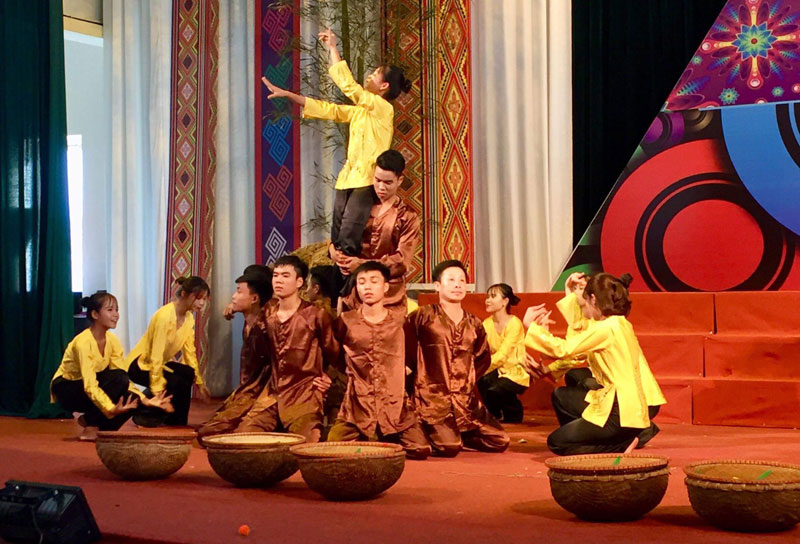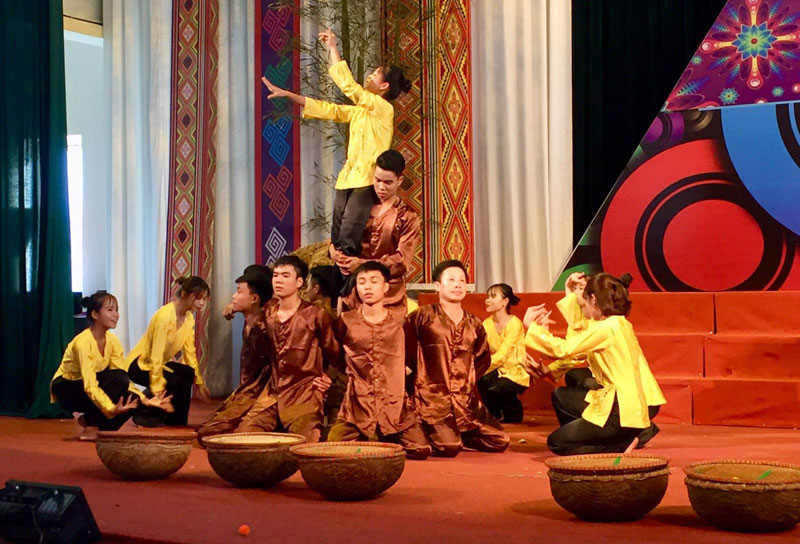
(HBO) - Tan Lac district of Hoa Binh province has successfully organized an agitprop competition festival for 2018, drawing more than 400 actors and artisans from 22 troupes from communes and towns across the district.

Performances at the Tan Lac district agitprop festival
for 2018.
In two days, the
teams competed in three sections – presenting for photo exhibitions, doing
plays for communications, and performing art with a concreted theme.
According to the
organising board, nearly 70 performances were presented at the festival, proving
that the teams had invested greatly in content, costumes and props. In
particular, the topics chosen by the teams were mostly about new-style rural
area building, security and order, traffic safety, domestic violence prevention,
and tourism.
At the end of the
competition, the board awarded 12 A prizes, 12 B prizes and 24 C prizes in the
categories of photo exhibition narration, art and communication plays.
Concluding the
festival, it presented two A prizes to the teams of Quyet Chien and Phong Phu communes,
four B prizes to Ngoc My, Do Nhan, Ngoi Hoa and Dong Lai communes, and six C
prizes to Quy Hau, Ngo Luong, Thanh Hoi, Phu Cuong, Tuan Lo communes and Muong
Khen township. In addition, the board also gave the "Excellent Communicator” Award
to Ngo My commune, and the best visual tool award to Quyet Chien commune.-VNA
With an increasingly vibrant and widespread emulation movement aimed at building cultured residential areas and cultured families, Yen Thuy District has been making steady progress toward improving both the material and spiritual well-being of its people, while fostering a civilized, prosperous, beautiful, and progressive community.
Once lacking recreational spaces and community facilities, Residential Group 2 in Quynh Lam Ward (Hoa Binh City) has recently received attention for the construction of a new, spacious, and fully equipped cultural house. The project followed the model of state support combined with public contributions in both labor and funding.
The "All people unite to build cultural life" movement, which has been effectively integrated with Kim Boi district’s socio-economic development goals, is fostering a lively spirit of emulation across local residential areas, hamlets, villages, public agencies, and enterprises. In addition, through the initiative, traditional cultural values are being preserved and promoted, while community solidarity and mutual support in poverty reduction and economic development are being strengthened.
A working delegation of the Hoa Binh provincial People’s Committee led by its Permanent Vice Chairman Nguyen Van Toan on June 11 inspected the progress of a project to build the Mo Muong Cultural Heritage Conservation Space linked to tourism services in Hop Phong commune, Cao Phong district.
Born and growing in the heroic land of Muong Dong, Dinh Thi Kieu Dung, a resident in Bo town of Kim Boi district, in her childhood was nurtured by the sweet lullabies of her grandmother and mother. These melodies deeply imprinted on her soul, becoming an inseparable part of her love for her ethnic group's culture. For over 20 years, this love for her hometown has driven Dung to research, collect, and pass down the cultural values of the Muong people to future generations.
In the final days of May, the Ethnic Art Troupe of Hoa Binh Province organized performances to serve the people in remote, mountainous, and particularly disadvantaged areas within the province. These were not just ordinary artistic shows, but they were the meaningful journeys aimed at spreading cultural values, enhancing the spiritual life of the people and contributing to the preservation of ethnic minority cultural identities.



